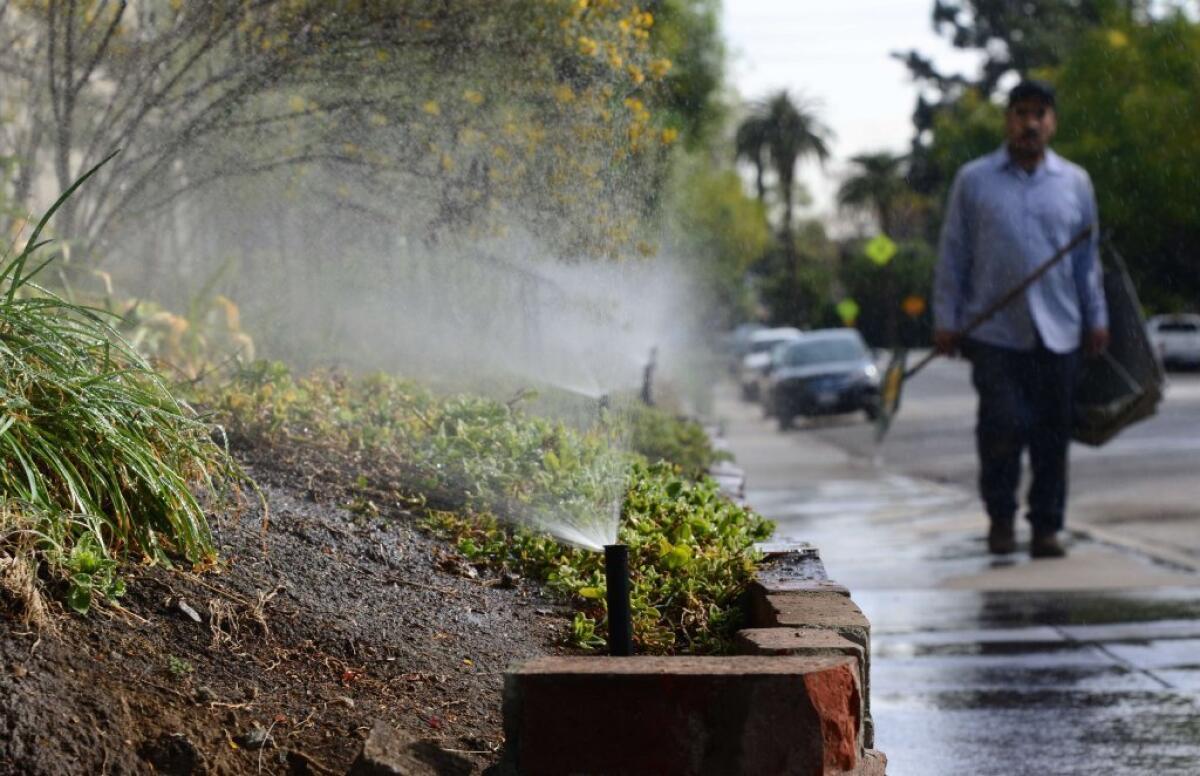What L.A. can do to prepare for a drier future

Los Angeles uses less water per capita than any other U.S. city with more than 1 million people: about 123 gallons per person per day. Although the city is setting an example for the rest of the state, it can do much more. California is in a severe drought, and the water supply is expected to remain uncertain from year to year. We suggest the most straightforward path in L.A. to proactively plan for a drier future is to install dual residential water meters, one for indoor water use, the other for outdoor water use.
Research we have conducted at UCLA and the Colorado School of Mines shows that from 40% to 60% of water use in the city of Los Angeles is for irrigation. Current mandatory restrictions and price increases have reduced water usage 23% since 2009.
Looking at satellite imagery from before and during conservation efforts, the city did not measurably decline in greenness, including in the warmer regions of the San Fernando Valley. But overwatering is still the norm, and many landscapes are more appropriate for climates that get 30 inches of rain annually. Further reducing irrigation and changing landscaping are the next big frontiers for water conservation in Los Angeles, the region and many parts of the state.
The challenge is to maintain affordability for indoor use and to reform institutional cultures that stand in the way. Dual metering, with differential water pricing and increasing tariffs for outdoor water, would ensure that people will have affordable water for their daily needs while also increasing conservation. It would also ensure that indoor water pricing reflects family income, similar to the current life-line rate.
The technical solution involves installation of a so-called sub meter to measure all exterior water use. This is already possible. The Department of Water and Power sells meters for $255 that the homeowner can install to measure outdoor water use. It also can provide a bill that shows exterior usage. What is needed is for the DWP to promote and support this solution, differentially price outdoor water use and actively help homeowners understand this opportunity to better manage their water use.
If the DWP’s culture embraces this as a method to conserve and offers customers a program with incentives, financed by charging more for the outdoor water, the economies of scale would make this an affordable strategy. This structure would help pay for a meter installation program.
The DWP currently has a two-tier allotment and pricing system, with usage beyond Tier One costing more. Our research found that Los Angeles neighborhoods with higher incomes use up to three times as much water as other areas. It’s not surprising that larger properties and larger houses use more water, even at Tier Two’s higher prices. Higher outdoor water prices — say a new Tier Three — would send a price signal to reduce outdoor water use, and could do so significantly depending on the price.
We also found that users who mostly stayed within Tier One allotments reduced their water use proportionately more than those whose usage extended into Tier Two. It would appear that lower-income residents are more price sensitive to water charges, and higher-income households are insensitive to the current pricing structure. Therefore, outdoor water use should be more expensive.
Tier Three should be accompanied by strong DWP messages about water abusers and potential fines above a certain threshold of use, calculated on property size. While it is unrealistic to cut off outdoor water use entirely, under drought conditions and greater water scarcity going forward, everyone needs to act responsibly.
As a complement to monitoring outdoor usage, we need to do more to replace our landscaping with drought-resistant plants. There are many ornamental plants that can thrive in this region, including trees and flowers. We can transform planting strips into areas for water retention and filtration zones, and cooling belts with climate-appropriate shade trees. Many dry regions have figured this out, implementing beautiful plantings with permeable surfaces like decomposed granite to encourage what rain does come down to infiltrate into groundwater.
Southern California and the Southwest have been blessed with an extraordinary water infrastructure built over the last 80 years. We have been enormously fortunate to have had an anomalously wet last century. But we have become spoiled, taking water for granted as we liberally water sidewalks and streets with overspray, wash down hard surfaces and wash our cars too often.
But water is life, and the conditions have changed. We must treat it as the precious resource it is and live within its limits. Dual meters and changed landscaping can be part of a broader vision that aggressively pursues each and every opportunity to conserve and save water.
Stephanie Pincetl is director of the California Center for Sustainable Communities at the Institute of the Environment and Sustainability at UCLA. Terri Hogue is an associate professor of civil and environmental engineering, and the associate director of hydrologic sciences and engineering at the Colorado School of Mines.
More to Read
A cure for the common opinion
Get thought-provoking perspectives with our weekly newsletter.
You may occasionally receive promotional content from the Los Angeles Times.






